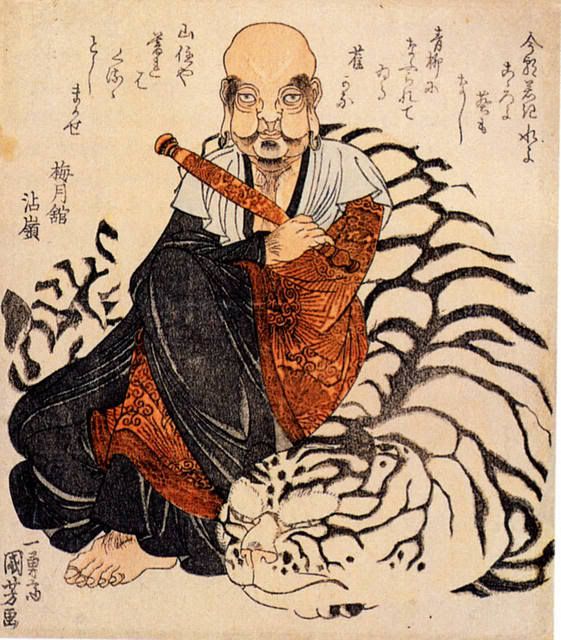A Good Description From: http://www.ancientmuseumstore.com/Samurai_in_Attack_Utagawa_Kuniyoshi_p/ku04.htm
The world portrayed by the art of Japanese printing can be captured under one romantic, by origin Buddhist, name - ukiyo-e, or the floating world. It's a world of brief amusement and pleasure - of daily life like it took place between the 17th and 19th century in theatres, on the street and during parties and festivals. Before the ukiyo-e period Japanese art was mainly about images which pleased the Japanese feudal lords - grand, colorful and elegant works of art which portrayed courtly life, made by artists who belonged to the traditional Kano and Tosa school. Little could be seen of daily life of the Japanese people. Every now and then one could catch a glimpse of the forthcoming ukiyo-e period which would portray common life in all its glory, with a leading part put aside for actors and courtesans. This changed when ukiyo-e made its entrance. After a turbulent period of political turmoil, the Tokugawa period commenced - a period which would herald a strict, dictatorial regime by the so-called Shoguns, who belonged to the Tokugawa family.
To control the population, social life was restricted and entertainment for the common Japanese was limited to parties and festivals. The artists belonging to the traditional schools like the Kano and Tosa school adapted to this new era and woodblock prints emerged presenting every day life. Soon these woodblock prints became very popular and the Tokugawa period counts as a milestone for the art of Japanese printing. Initially a print was a cheap derivative of the traditional art of painting. Due to advancing woodblock print techniques the art of wood block prints developed into a full and popular art form during the 18th century. To make a woodblock print the artist worked closely together with various craftsmen. He drew his design on a translucent piece of paper, the hanshita-e. The paper was dampened and carefully traced by the copyist onto a plate of cherry wood. The engraver carefully carved out the fine graved cherry wood, along the lines of the design, removing everything but the design lines. He could not afford to make a simple mistake, because it was irretrievable. However, his work was more than purely that of a craftsman. He was expected to revise the sometimes rough sketch of the artist into fine, fluent lines in relief in the wood. Then the artist indicated which planes should get which color and a plate was cut per color. The printer prepared and cut special paper which was made from fiber of the mulberry tree. He first printed the color planes and then meticulously the line drawing. For the paint he used materials of vegetable origin.When we look at the wood block prints now we should realize that many of the original colors have faded over the years. The publisher was the organizational and commercial keyman during the process. He gave the artist the assignment and paid the craftsmen. Sometimes the prints were put onto the market by the thousands. Because of this they became affordable, which obviously contributed to their large popularity. With this in mind it seems unjust that for a long time only the name of the artist, sometimes the name of the engraver and only seldom the publisher, was mentioned on the print.
Shown Below:
Hattara Sonja with his white tiger:
Thursday, February 21, 2008
Ukiyo-e - The Art of Japanese Printing
Subscribe to:
Post Comments (Atom)






1 comment:
Thanks for the comments on my post.
I'm sorry but I don't give permission for other people to use my work on their blogs when it's a work which I have copied for educational purposes. It has to stay on my blog where it is shown with both my statement and my copyright notice. It's just a general principle which I apply irrespective of whether the work is in or out of copyright.
I've no objections to you linking to the post.
Post a Comment